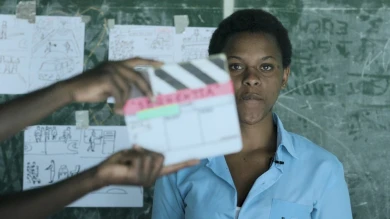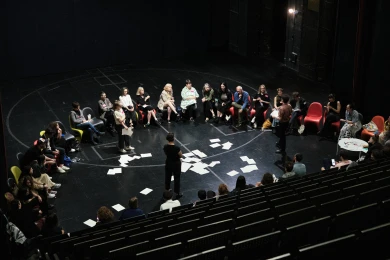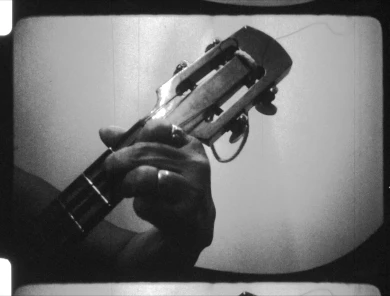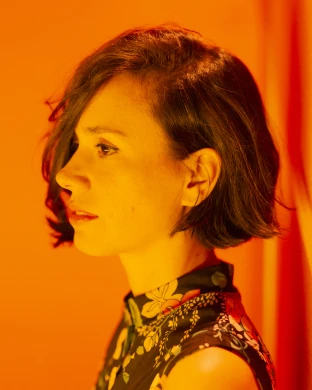-
February 26, 2015 Sabatini Building, Auditorium
Session 1
Luis Ospina and Carlos Mayolo. Agarrando pueblo 1977, 16 mm, colour, b/w. 27’
Luis Ospina. Ojo y vista: peligra la vida del artista. 1987, U-matic, colour. 26’
With Luis Ospina in person
In the sense of “fooling”, yet also “prefabricating”, Agarrando pueblo shows the shooting of a fictitious film entitled ¿El futuro para quién? (Whose Future?), intended for broadcast on European television sets. The directors recreate images of underdevelopment in the hurried dictation “what more misery is there?”, a phrase uttered by one of them. Agarrando pueblo shook-up film-making methods: it exposed an orthodox documentary system that freely exploited social scourges – the so-called “cine del sobreprecio (surcharge cinema)” – and renounced the way certain films considered vérité filtered and manipulated reality. Likewise, it set in motion humour and satire as critical and involved tools of film practice. Ten years after winning awards at festivals in Oberhausen and Lille, they made the epilogue Ojo y vista: peligra la vida del artista, a film in which Ospina maximised the new medium of video to reassemble and revisit a scene from Agarrando pueblo: a well-known street performer who, in his proclamations on abandonment and resistance, appears to mirror any other Colombian artist.
-
27 February, 2015 Sabatini Building, Auditorium
Session 2
Luis Ospina and Carlos Mayolo. Oiga vea. 1972, 16 mm, b/w. 27’
Luis Ospina and Carlos Mayolo. Cali: de película. 1973, 35 mm, colour. 14’
With Luis Ospina in person
Coalesced around the magazine Ojo al cine and the local cinema club, the city of Cali would experience an intense film movement during the 1970s, with the late writer Andrés Caicedo and film-makers Luis Ospina and Carlos Mayolo, among others, at the core. Both films are the outcome of what was known as Caliwood. Oiga vea documents exclusion in the VI Pan-American Games and is edited with contrasts as the presentations and official anthems give way to shanty towns and slums facing monuments and empty stadiums, police and military occupation and the geopolitical tension between Cuba and the USA within an event that takes the city hostage. In Cali: de película, Ospina and Mayolo go to great lengths to transfer the urban landscape of Jean Vigo in A Propos de Nice (1930) to the Cauca Valley city. Festivities, carnival and daily humour in the face of either violence or the theatricality of public life show, in Ospina’s words, that everything is a disguise and forms part of the same ritual.
-
2 March, 2015 Sabatini Building, Auditorium
Session 3
Luis Ospina. Pura sangre. 1982, 35 mm, colour. 98’
One of the best examples of the so-called “tropical gothic”, a sub-genre comprising the translation and deviation of conventions and narrative frameworks in order to consider a real theme from fiction and parody. Pura sangre mixes together two myths: the vampire of Western culture and the “monster of the valley”, a serial child killer and rapist in 1970s Colombia. In the film an ailing and bedridden tycoon survives through mass blood transfusions taken from young men, kidnapped by his employees. The story is used to present a case of age-old exploitation and corruption, where high society “bleeds dry” peasants paralysed by fear, with the help of a corrupt middle class.
-
3 March, 2015 Sabatini Building, Auditorium
Session 4
Luis Ospina. Un tigre de papel. 2007, Betacam Digital. 114’
Concerned throughout his work with the preservation of film archives, the conditions for artistic practices in Colombia and the particular narration from Latin America, Un tigre de papel seems to synthesise the combination of the film-maker’s interests, translated into his irreverent artistic code of play and humour, where there is no greater truth than the one discovered by a lie. Un tigre de papel recounts the life of a pioneer of collage in Colombia, Pedro Manrique Figueroa, an activist and militant artist, the alter-ego of so many Latin American artists participating in the networks of visual poetry and mail art, who, before his disappearance, unsuccessfully tried to donate himself to the Museo de Arte Moderno in Bogotá. This fictitious life allowed Ospina to trace a wide panorama of art and public life in Colombia with the participation of many of its protagonists.
Luis Ospina, Triple Agent

Held on 26, 27 feb, 02, 03 mar 2015
Together with Carlos Mayolo, Luis Ospina has directed some of the most incisive and critical films on the identity stereotypes that are still prevalent in the cultural imaginary of Colombia and, by extension, Latin America. Setting out from the term “porno-miseria”, his work explicitly speaks out against the obscene use of violence and extreme poverty as a spectacle.
This film series, with the film-maker present, serves as an introduction to his work. The triple agent, which lends its name to this programme, is a collage by the artist Pedro Manrique Figueroa, portraying, autobiographically, the ambiguous relationship between art and politics in the Latin America of this renowned, fictional artist, who is the focal point of the film Un tigre de papel (2007), Luis Ospina’s fictional documentary that concludes the series.
The triple agent is also the role the Colombian film-maker undertakes in his relationship to multiple debates, movements and schools – from the militant cinema of the 1960s and 1970s to video activism in the 1980s, from documentary realism to the poetics of underdevelopment. Despite his constant participation in all of them, he exposes their biased inclination towards stereotypes or towards representative paternalism and perpetually explores their critical tension. This retrospective shows the director’s confrontation in Agarrando pueblo (co-directed with Carlos Mayolo, 1978), in which social protest, the limits of film language and the ethics of participation are explored over four sessions that feature input from the film-maker.
Framework
ARCO Colombia 2015
In collaboration with
Government of Colombia
Curatorship
Chema González
Organised by
Museo Reina Sofía
Más actividades

Christian Nyampeta and the École du soir
13, 14, 15 NOV, 11, 12, 13 DIC 2025
Christian Nyampeta is a Rwandan artist, musician and film-maker whose work encompasses pedagogies and community forms of knowledge production and transmission. His Ècole du soir (Evening School) is an art project conceived as a mobile space of collective learning and is named in homage to Ousmane Sembène (1923–2007), a pioneer of African cinema who defined his films as “evening classes” for the people, a medium of education and emancipation through culture.
This block is made up of three double sessions: the video work of Christian Nyampeta, the films of École du soir and one of Ousmane Sèmbene’s feature-length films. Nyampeta will introduce all three first sessions.

UP/ROOTING
11, 12, 13, 14, 15, 16 NOV 2025
Museo Reina Sofía and MACBA Museu d'Art Contemporani de Barcelona (MACBA) invite applications for the 2025 iteration of the School of Common Knowledge, which will take place from November 11th to 16th in Madrid and Barcelona.
The School of Common Knowledge (SCK) draws on the network, knowledge and experience of L’Internationale, a confederation of museums, art organizations and universities that strives to reimagine and practice internationalism, solidarity and communality within the cultural field. This year, the SCK program focuses on the contested and dynamic notions of rooting and uprooting in the framework of present —colonial, migrant, situated, and ecological— complexities.
Building on the legacy of the Glossary of Common Knowledge and the current European program Museum of the Commons, the SCK invites participants to reflect on the power of language to shape our understanding of art and society through a co-learning methodology. Its ambition is to be both nomadic and situated, looking at specific cultural and geopolitical situations while exploring their relations and interdependencies with the rest of the world.
In the current context fraught with war and genocide, the criminalization of migration and hyper-identitarianism, concepts such as un/belonging become unstable and in need of collective rethinking:
How can we reframe the sense and practice of belonging away from reductive nationalist paradigms or the violence of displacement? How to critically hold the entanglement of the colonial routes and the cultural roots we are part of? What do we do with the toxic legacies we inherit? And with the emancipatory genealogies and practices that we choose to align with? Can a renewed practice of belonging and coalition-making through affinity be part of a process of dis/identification? What geographies —cultural, artistic, political— do these practices of de/centering, up/rooting, un/belonging and dis/alignment designate?
Departing from these questions, the program consists of a series of visits to situated initiatives (including Museo Situado, Paisanaje and MACBA's Kitchen, to name a few), engagements with the exhibitions and projects on view (Project a Black Planet: The Art and Culture from Panafrica), a keynote lecture by Stefano Harney and Fred Moten, as well as daily reading and discussion gatherings, editorial harvest sessions, and conviviality moments.

The Joaquim Jordà Residencies 2025
Friday, 7 November 2025 - 7pm
In this activity, the recipients of the 2024–2025 Joaquim Jordà Residencies call, María Aparicio (Argentina, 1992) and Andrés Jurado (Colombia, 1980), present respective projects related to their body of work in an open session in which to discover the creative interests of two of the most up-and-coming independent film-makers in Latin America today.
María Aparicio presents the working process behind her film De sol a sol (From Sun to Sun), along with a brief journey through the films prior to this project and her filmic searches in recent years. Aparicio synthesises the storyline of De sol a sol from the silhouettes of a group of men who appear between the stalks of a reedbed. Their knives glisten as the sun hits them, flashing and disappearing with their hand movements. Apprentices split the canes using no method; seasoned workers cut with skill. They are workers from a sugar mill in northern Argentina and are watched by Juan Bialet Massé, accompanied by Rosich, assistant and photographer. It is Argentina in 1904 and he is carrying out a mission assigned to him by his country’s government: to travel the Argentinian provinces, reporting on the state of the working classes.
Andrés Jurado, for his part, will look over his own work and the work of the La Vulcanizadora lab in this session. He will also open the archive stemming from the research process in the project Tonada, a journey through the succession of peace agreement betrayals in the history of Colombia. From the colonial era, understood in tumultuous terms, as a hurricane that keeps swirling, to the present day he traces the stories of people like Tacurrumbí, Benkos Biohó, Bateman and the many women and men who were betrayed by governments and oppressors. Tonada seeks to build a sound and film dialogue between the guerrilla disarmament of 1953 and the period following the peace agreement of 2016, invoking these and other events and confronting traumas of betrayal through a film composition devised to be sung. But what is sung? Some of these songs are heard and voices are shared in this presentation.
The Joaquim Jordà Residences programme for film-makers and artists was set in motion by the Museo Reina Sofía in 2022. The initiative comprises a grant for writing a film project rooted in experimentation and essay, as well as two subsequent residencies in FIDMarseille and Doclisboa, international film festivals devoted to exploring non-fictional film and new forms of audiovisual expression.

Ylia and Marta Pang
Thursday, 6 November - 8pm
The encounter between Spanish DJ and producer Ylia and visual artist Marta Pang is presented in the form of a premiere in the Museo Reina Sofía. Both artists converge from divergent trajectories to give form to a new project conceived specifically for this series, which aims to create new stage projects by setting out from the friction between artists and dialogue between disciplines.
![Carol Mansour y Muna Khalidi, A State of Passion [Estado de pasión], 2024, película](https://recursos.museoreinasofia.es/styles/small_landscape/public/Actividades/palestine%20cinema%20day%202.jpg.webp)
Palestine Cinema Days
Sábado 1 de noviembre, 2025 – 19:00 h
The Museo Reina Sofia joins the global action in support of Palestine with the screening of A State of Passion (2024), a documentary by Carol Mansour and Muna Khalidi. The film features in Palestine Cinema Days Around the World, an annual festival, held globally every November, which aims to show films made in Palestine to an international audience. The initiative was conceived as a form of cultural resistance which seeks to give a voice to artists from Palestine, question dominant narratives and create networks of solidarity with the Palestinian people.
Palestine Cinema Days Around the World originates from Palestine Cinema Days, a festival organised in Palestine since 2014 with the aim of granting visibility to Palestinian cinema and to support the local film community. In 2023 the festival was postponed because of the war in Gaza, and has since become borderless in scope, holding close to 400 international screenings in almost sixty countries in 2024. This global effort is a show of solidarity with Palestine and broadens the voices and support networks of the Palestinian people around the world.
A State of Passion exposes the atrocities committed against the Gaza population via the testimony of Dr Ghassan Abu Sittah, a Palestinian-British plastic surgeon living in London who decides to return to Gaza and save lives in the city’s hospitals amid the Israeli army’s indiscriminate bombing of the population. A necessary film exposé of the experience of unrelentingly working twenty-four hours a day for forty-three days in the Al Shifa and Al Ahli Hospitals in the city of Gaza.



![Miguel Brieva, ilustración de la novela infantil Manuela y los Cakirukos (Reservoir Books, 2022) [izquierda] y Cibeles no conduzcas, 2023 [derecha]. Cortesía del artista](https://recursos.museoreinasofia.es/styles/small_landscape/public/Actividades/ecologias_del_deseo_utopico.jpg.webp)
![Ángel Alonso, Charbon [Carbón], 1964. Museo Reina Sofía](https://recursos.museoreinasofia.es/styles/small_landscape/public/Actividades/perspectivas_ecoambientales.jpg.webp)